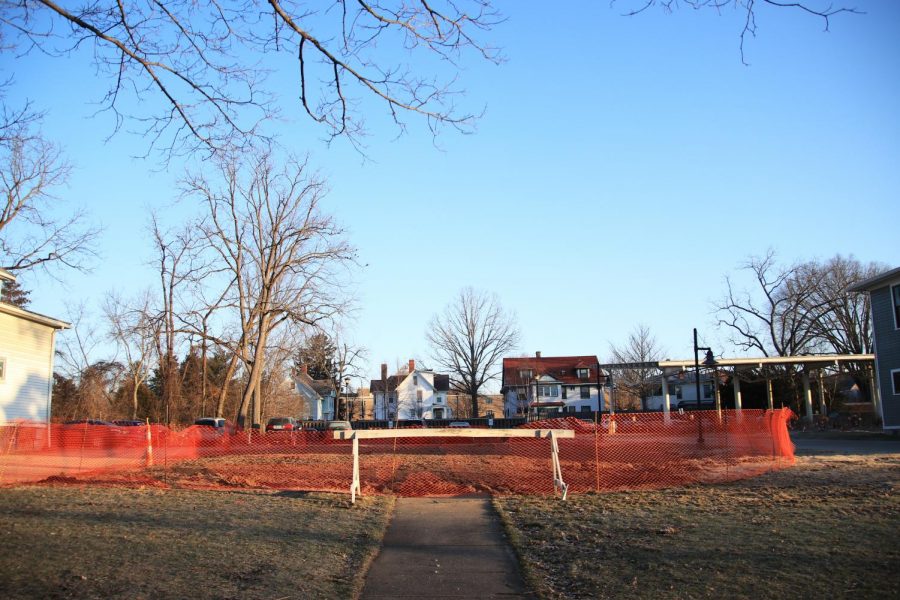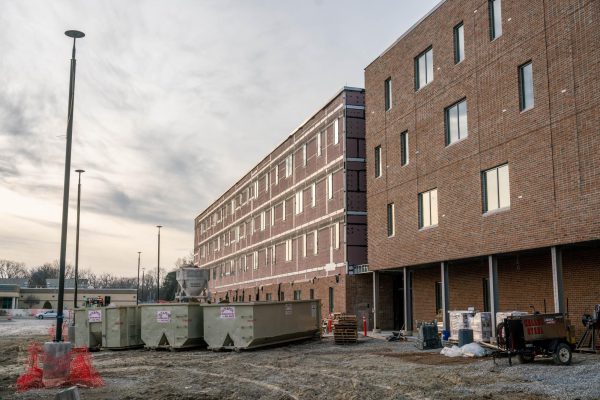Community Responds to College’s Demolition of Village Housing
A vacant lot on Elm Street. The College has completed demolitions of seven Village Housing Units since January after filing to do so in November.
Last month’s demolition of seven Village Houses has sparked conversation over whether the College should have been more intentional in consulting the surrounding community before making the decision to tear the houses down. The College currently has no plans to build on the vacant lots, and some residents are concerned about how the demolition could change the character of their neighborhoods.
Carrie Handy, director of planning and development for the City of Oberlin, says her office has received a few questions.
“Obviously, they’re concerned about what might go there in the future,” Handy said. “I guess maybe they thought, you know, ‘Is it going to be student housing? Is it going to be … just a single-family house?’ Those kinds of questions. They’re just not certain of what’s going to happen in the future.”
According to Vice President and Dean of Students Meredith Raimondo, it is primarily Facilities Operations’ job to communicate to the City about any demolition or construction through the permitting process.
She believes that it is up to the City, not the College, to communicate directly to residents. However, she does agree that the College must be cognizant of the way its actions affect residents.
“I think it’s really important for the College — as an institution — to be a good neighbor,” Raimondo said. “And because it does own properties that are in neighborhoods, that includes thinking about its presence in those neighborhoods. That principle, to me, should always guide — and I believe and hope always does guide — the work that we do that touches residential neighborhoods.”
Because the College is a nonprofit organization, it’s exempt from a majority of property taxes. While the College does not pay a property tax on its academic buildings, it does have to pay property taxes on Village Houses. With the demolitions, however, the College will pay less in property taxes for these lots, which will sharply decrease in value.
“They’ll still pay a little bit of property tax, but not to the extent that they were,” City Councilperson Kelley Singleton said. “So, of the houses that have come down, they were paying around $20,000 a year in property tax. Now that money will go away: $10,000 of that will not go to the local schools, [and] $1,200 a year won’t go to the library to help fund that. So it might not sound like a lot of money, but try going into the library and asking them for a check for $1,200 and see how far you get.”
This is not the first time in recent memory that questions have arisen regarding how the College should engage with its largely tax-exempt status. Back in 2015, students made an unsuccessful push for the College to contribute a payment to the City in lieu of property taxes, a fee that some nonprofits voluntarily agree to pay to offset their tax-exempt status (“Students Push for Agreement on College Taxes,” The Oberlin Review, Dec. 12, 2015).
Singleton suggested that a possible option for town-gown collaboration on housing and property issues could be the Oberlin Community Land Trust, a new nonprofit that seeks to create affordable housing for low-income people, seniors, families, and first-time homeowners.
Krista Long, owner of Ben Franklin & MindFair Books, is the land trust’s president. She says that the College previously offered houses to the Oberlin CLT but that they were not the right fit for the organization at the time. However, the Oberlin CLT was not consulted with regard to the seven properties that were recently demolished.
With the College looking to downsize its physical footprint after the release of the Academic and Administrative Program Review final report, Long had hoped that the administration would seek to work with local organizations to address this problem.
“What are they going to do with that property?” Long said. “I would like to see them turn it over to an organization like ours so that we can get affordable housing on the street. Oberlin College probably has another plan.”
Singleton echoed Long’s feelings of uncertainty.
“When the College uses the word ‘community,’ they don’t mean Oberlin,” Singleton said. “They mean Oberlin College. I would like it to be a community, not just separate entities. … Let’s have One Oberlin, one where it’s all of us together trying to raise the ship together.”
Long says that her organization is open to collaboration with the College in the future but echoes Singleton in saying that communication can sometimes be a challenge.
“It’s a chronic problem and a chronic two-way problem,” Long said. “When you have an institution like Oberlin that is such a large part of the community — a large property owner, a large employer, a large consumer of utilities — all of those things affect the way the City makes decisions. While there has been some improvement in that, I think it’s a struggle.”







